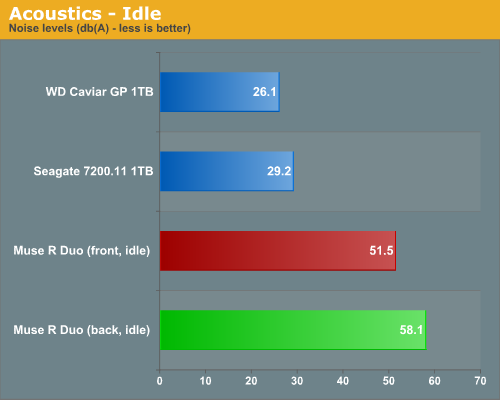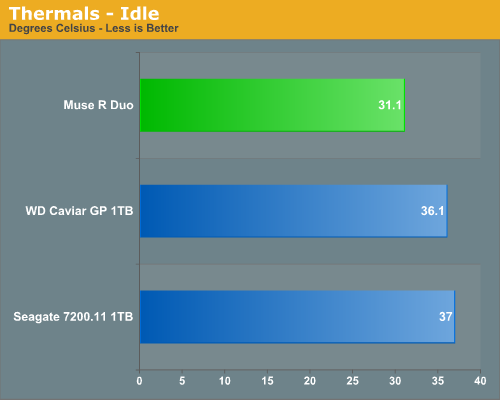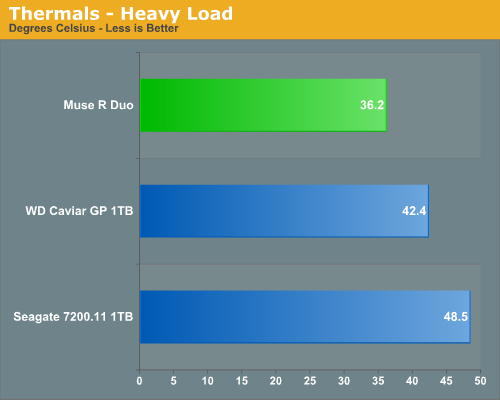Thermaltake Muse R-Duo: External RAID
by Dave Robinet on December 14, 2007 2:00 AM EST- Posted in
- Storage
Acoustics
As this is an external device, we are able to take advantage of long cable runs to ensure that the Muse R-Duo is in a physically separate room from the host computer. We will test the unit under drive operating conditions, as well as separately to check the noise levels of the Thermaltake cooling solution.
For the drive operating portion, our acoustic tests measure the decibel levels while the system is at idle and under load while running the General Hard Disk Drive Usage benchmark within PCMark 2005. We found through trial and error that this particular benchmark produces controlled readings across a wide range of applications within the benchmark. This particular benchmark utilizes 60% reads and 40% writes within the trace playback file.
We take measurements at a distance of 5mm from the rear and front of the enclosure in order to minimize surrounding environmental noise. We have noticed that unless we run a completely silent system in a quiet room that measurements taken from 1m are generally not meaningful due to ambient noise levels. There are exceptions like the Raptor series of drives but overall most modern desktop drives are quieter now than the other components in the system while under load.
The reported measurements use an A-weighted decibel score that measures frequencies similar to the way the human ear responds to sound. We take three measurements for each test. We then subtract the high and low scores and arrive at our findings by reporting the remaining score.


The Muse R-Duo is far from silent, with the small fan blowing a significant amount of air through the enclosure. The noise actually reverberates in the enclosure somewhat, making it that much louder. Even under heavy load, the fan completely obscures the sound of the hard drives.
Thermals
Our thermal tests utilize sensor readings via the S.M.A.R.T. (Self-Monitoring, Analysis and Reporting Technology) capability of the drives, gathered using the Active SMART 2.6 utility. Note that we upgraded from version 2.42, which we used in our previous tests; in re-running several benchmarks we were able to confirm that no results changed as a result of the update. We also utilize thermal sensors and infrared measurement devices to verify our utility results. We test our drives in an enclosed case environment without the fans operational to simulate running in a near silent SFF or HTPC case design. We typically find the reported numbers drop anywhere from 18% to 25% when the case fans are operational. Our base temperature level in the room at the time of testing was 25C.


The Muse R-Duo does a very good job keeping the two Seagate drives cool - its loaded temperature comes in beneath the idle temperature we observed in our normal benchmark procedure when testing the bare drive. Note again that we conduct the system test without case fans operational, so it reflects a far worse scenario. Still, having the hard drives run that cool while sitting nearly adjacent to each other is an impressive feat, and a testament to the pedigree of strong cooling that Thermaltake brings to the table. The acoustic results and temperature results are two sides of the same coin, of course: louder fans creating airflow reduce temperatures and a lack of fans and airflow causes them to rise.










11 Comments
View All Comments
Magendanz - Friday, December 14, 2007 - link
Actually, I think this should be targeted aggressively at the small business market. There's really no cheaper or easier way to protect your critical business records against a drive failure. Just buy it, insert two SATA drives, set a DIP switch, and attach it to your existing PC. Drive performance is really secondary.